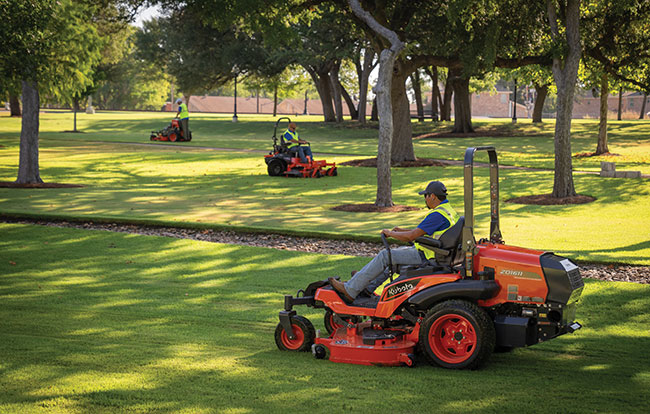
Features
Equipment
Mowers
Tips for selecting commercial ZTRs and questions to narrow down options
Many questions need answers before choosing the ZTR mower that best fits your needs
July 2, 2024 By Justin Parrott
 Commercial mowers within a manufacturer’s product line may have similar specifications, but not all of them may fit your needs. Photo: Kubota Canada
Commercial mowers within a manufacturer’s product line may have similar specifications, but not all of them may fit your needs. Photo: Kubota Canada Looking for a new mower can be a daunting task, with numerous styles available in the industry. While all of them cut grass, some perform better in certain applications. Even within a manufacturer’s mower lineup, there can be a variety of mowers that have very similar specifications, but not all may fit your needs. When deciding on a new mower, there are a few questions that can help narrow down the offering.
- How large are the properties that you mow?
- How many hours per week do you anticipate putting on the machine?
- How often do you plan on trailering?
- What kind of terrain will you have to cover with your new mower? Lots of slopes, rough ground, ditches?
- Are there any other task outside of mowing you wish to perform?
In addition to these questions, it’s important to also weigh the pros and cons of specific mower configurations and setups to assess which type of commercial mower will work best for you. The three most common ride-on commercial mowers seen are the traditional ride-on zero turn, stand-on zero turns and front mount mowers. These three machines all cut grass, but each have unique advantages that should be considered.
Ride-on zero turn
The ride-on zero turn is your Swiss army knife for commercial mowing. They find the right balance between maneuverability in tight areas, operator comfort for large properties and a variety of mower deck and chassis sizes. These three-season machines can be outfitted with attachments, such as grass catchers, and can usually pull small tools on the rear, allowing you to expand services being offered.
Stand-on zero turn
Stand-on mowers have been gaining strong popularity in recent years amongst contractors. Compared to a traditional zero turn, their smaller wheelbase makes them more maneuverable in tight areas and allow for more machines to fit on a trailer. Getting on and off the machine is a lot quicker and requires less effort which is beneficial for smaller residential properties where debris needs to be picked up or gates opened. Some operators also have a greater sense of confidence on hillsides with stand-on mowers, as they allow an operator the ability to lean with the bank. Attachments are usually limited for stand-on mowers, making them more of a “grass cutting only” machine.
Front-mount mower
As the name suggests, front-mount mowers place the mower deck ahead of the operator. For long operating days, this increases overall operator comfort by reducing the need to consistently look towards the sides of the machine. Additionally, the mower deck ahead of the machine provides the ability to trim underneath obstacles such as park benches, shrubs or fences. For added hillside stability, some machines come with 4WD, delivering better traction when climbing or descending slopes. For a business that needs to operate in all seasons, a front-mount mower may be an attractive option, as you can easily take the mower deck off the front of the machine and attach a variety of snow attachments in the winter months.
The types of contracts a business will bid on can also impact mower purchase decisions. Safety is often top of mind for public contracts, where rear discharge mower decks may be an advantage, as they eject grass clippings under the rear of the machine where it can safely drop. This reduces the risk of accidentally ejecting grass or debris compared to a side discharge configuration that can eject clippings in an unwanted direction. Adding a rear discharge mower to your fleet may give you a leg up on the competition when bidding on these contracts.
After selecting the mower type that is right for you, it’s also important to select a mower deck size that’s the right fit for the types of properties you will be working on.
When assessing mower deck size, it’s important to consider the smallest opening the machine must travel through. Do you have narrow passageways or entrance gates to properties that the machine must pass through? If passageways aren’t a concern, contractors will often opt for a 54-inch or 60-inch mower deck width, as these sizes find the balance of high productivity while reducing potential scalping on uneven lawns. For large flat areas where acreage mower per hour is important, mower deck sizes of 72 inches or more can be opted for to maximize acreage per hour.
Once you’ve landed on the optimal mower deck size and your new mower has been purchased, it’s vitally important to familiarize yourself with the machine in a safe operating environment as you get used to its characteristics and controls. Before starting up the engine, read the owner’s manual to understand all machine controls and safety features unique to that particular model. Take the time to adjust the seat, armrest, control levers and parking brake in a position that is natural and comfortable. In an urgent situation, knowing and being able to quickly disable the machine can prevent potential harm.
With these questions and considerations in mind, you’ll be well on your way to selecting a new mower that will help maximize productivity for your commercial mowing business for many years to come.
Justin Parrott is Kubota Canada’s turf and RTV product manager.
Print this page
- Health & Safety: Staying a cut above health & safety training
- Steady growth anticipated in global artificial turf market: report